Whether you’re just getting started with photography or have been doing it for some time, let this photography cheat sheet be your comprehensive guide to understanding f-stop.
Aperture or f-stop is one of the terms you’ll continuously encounter throughout your photography journey, so understanding how it works is crucial to your practice. It may take some time and a lot of practice before you get the hang of it, but today’s featured photography cheat sheet should at least make the learning experience easier.
The cheat sheet below, which is part of an in-depth guide put together by Cole’s Classroom, covers everything you need to know about f-stop and its role in photography. Also known as the aperture, it’s one of the components that make up the exposure triangle, and refers to the size of the opening that lets light into the camera.

According to the guide, the f-stop can be as small as the pinhole of a camera obscura or pinhole camera — the simplest camera there is. As photography technology progressed, it enabled us to have full control over the f-stop to achieve both proper exposure and creative effects. The smaller the f-number, the larger the opening. In most lenses, the aperture can be as small as f22 or as large as f1.4.
The larger the aperture, the shallower the depth of field. This means you can use apertures as wide as f1.4 to get a prominent blurring of the background or a pleasant bokeh. This works great for portraits. With the greater depth of field from small apertures like f16, you can get as much as of the scene in sharp focus — something that is useful in landscape photography.
The cheat sheet also briefly discusses how the exposure triangle works and the role of the aperture in it. We suggest checking out this exposure triangle cheat guide for a more in-depth discussion.
Liked these photography tips and tricks? Don’t forget to check out our photography cheat sheet collection to find more that will come in handy for your next shoot and projects!


